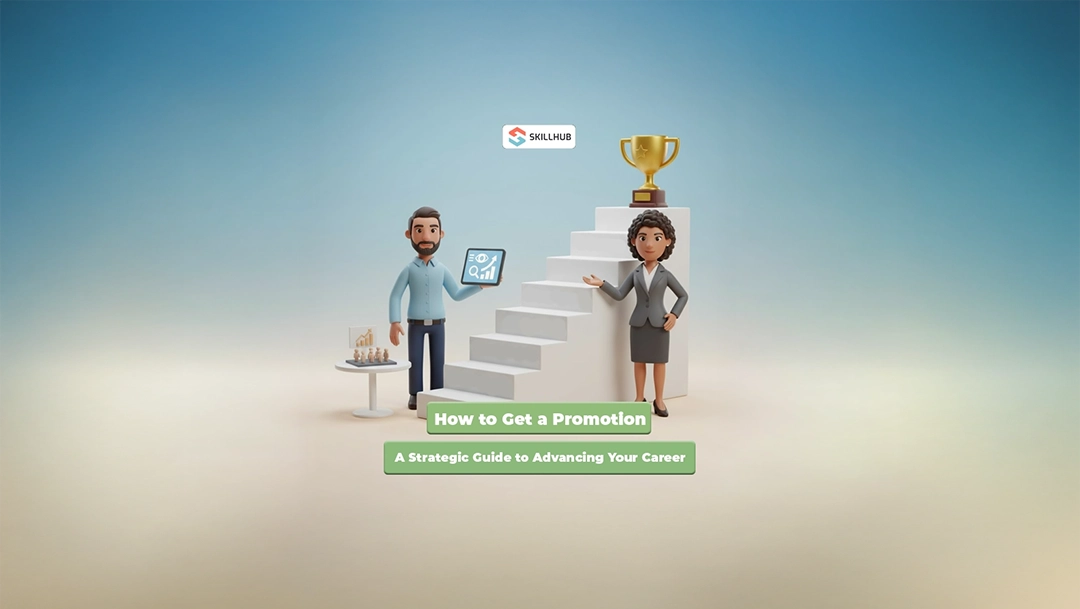How to Get a Promotion: A Strategic Guide to Advancing Your Career Internally

For most professionals, the path to promotion is a mystery. They operate under a dangerous, outdated assumption: that if they just keep their heads down, work hard, and "do a good job," someone will eventually notice and reward them. This is not a strategy; it is a lottery ticket. In the modern corporate world, a promotion is not a reward for your loyalty or tenure; it is a business decision made in response to a compelling case you build for yourself.
Waiting to be "chosen" is the slowest, least reliable path to advancement. The reality is that promotions are earned, negotiated, and strategically planned. Unlike an external job search where you are an unknown quantity, an internal promotion requires a completely different skill set. It's a game of visibility, internal politics, and proving your value before you get the new title.
This guide provides a rigorous, five-step strategic framework for getting promoted. We will discard the "wait and hope" model and replace it with an operational plan, treating your promotion as a dedicated internal campaign with you as the product.
The Foundational Mindset Shift: From "Doer" to "Leader-in-Training"
The single biggest obstacle to promotion is a psychological one. Most professionals are experts at their current job (the "doer" mindset), so they try to get promoted by simply doing more of that same job working longer hours, taking on more tasks, and becoming the "go-to" person for their current responsibilities. This is a trap.
This behavior doesn't signal you're ready for the next level; it signals that you are an incredibly efficient, valuable, and irreplaceable doer. You become so good at your current job that your manager can't afford to lose you.
The strategic shift is this: You are not promoted for mastering your current role. You are promoted for demonstrating you can already handle the responsibilities of the next one.
Your mindset must evolve from "How do I complete my tasks?" to "How does this business run, and how can I solve a bigger problem?" You must start acting like the leader you want to become long before the title ever appears on your business card.
Companies do not promote people who are ready for a promotion. They promote people who are already operating at the next level. Your job is to make their decision a mere formality a simple administrative change that recognizes the reality you have already created.
A 5-Step Strategic Plan for Internal Advancement
This is your campaign. It requires patience, visibility, and irrefutable data.
Step 1: Define Your "Why" and "Where" (The Career Audit)
You cannot get what you do not define. "I want a promotion" is a vague wish. "I want to move from 'Senior Analyst' to 'Data Science Manager' within 18 months" is a goal. Before you do anything, you must conduct a clear-eyed audit of your ambition.
- Define Your "Why": Be brutally honest with yourself. Are you seeking more money, more influence, a better title, or a different kind of work? This "why" will fuel your motivation and determine your targets.
- Define Your "Where": Analyze your company's organizational chart. Where are the logical next steps? Where are the bottlenecks, and where are the growth areas? Look for departments that are expanding, not shrinking.
- Identify Your Target Role: Find a specific next-level role. Pull its job description (even if it's an old one) and print it out. This becomes your new roadmap. You now have a gap analysis: the list of skills and experiences you currently have versus what that next job requires.
Step 2: Master Your Current Role (Build Your Foundation of Trust)
You cannot ask for more responsibility if you are fumbling the responsibilities you already have. This is the baseline. You must be an undeniable, top-tier performer in your current role. This is your "table stakes."
- Become the Expert: Be the person who not only does the job but understands why the job is done. Understand how your work connects to the department's P&L and the company's strategic goals.
- Document Everything: This is not optional. Start a private "Brag File" or "Accomplishments Folder" today. Every time you get a positive email from a client, save it. Every time you complete a project, write down the quantified result. This is the raw data you will use for your business case. This file will be your source for every future list of professional achievements.
Step 3: Communicate Your Ambition (The "Visibility" Phase)
This is where most people fail. They assume their hard work speaks for itself. It does not. You must make your ambitions known, or managers will assume you are happy where you are.
Your manager is the gatekeeper to your promotion. You must transform them from a "boss" (who assigns work) into a "sponsor" (who actively advocates for your advancement). This is done through direct, professional communication.
Do not do this in your annual review; that's too late. Do this in a regular one-on-one meeting.
Word-for-Word Script for Your Manager:
"I am really enjoying my work on this team, and my goal for the next 12-18 months is to advance my career here at [Company Name]. I am particularly interested in growing toward a role like [Your Target Role]. I know I'm not there yet, but I would value your honest feedback on what specific gaps I need to close to be considered a strong candidate for that kind of responsibility in the future."
This script is magic. It is non-threatening, humble, and proactive. It doesn't ask for the promotion today; it asks for guidance, which managers are paid to give. You have now made your manager a partner in your success.
Step 4: Solve Problems Outside Your Job Description (Prove Your Influence)
This is the "golden ticket" that separates you from every other "doer." Once you have mastered your job and communicated your ambition, you must find ways to add value beyond your defined role.
- Find the "Pain": Listen in meetings. What is the problem that everyone complains about but no one owns? Is it a broken reporting process? Is it poor communication between Sales and Marketing? Is it an outdated piece of software?
- Raise Your Hand: Volunteer to lead a small, cross-functional "task force" to solve one of these problems. This does two things:
- It gives you immediate, high-level visibility to other department heads.
- It allows you to demonstrate leadership skills even if you have no direct reports.
- Share the Credit: When you solve the problem, give credit to everyone who helped you. This shows you are a leader who builds up others, not just yourself.
Step 5: Build Your Business Case (The "Self-Evaluation" Strategy)
After 6-12 months of following these steps, your annual review or employee self-evaluation is no longer a simple review. It is the formal presentation of your "business case for promotion."
You will not walk in and ask for a promotion. You will walk in and demonstrate that you are already performing at the next level.
Your document should be structured like this:
- Excellence in Current Role: "Here are the 3 ways I exceeded all expectations for my current role, with quantified results."
- Demonstrated Performance at Next Level: "In addition to my core duties, I have proactively taken on responsibilities aligned with the [Target Role]. This includes:"
- [Example: "Led the cross-functional project 'Phoenix,' which solved [Problem] and resulted in [Quantified Win]."]
- [Example: "Mentored two junior analysts, helping them master [Skill] and improve their productivity by 20%."]
- Future Goals: "I am eager to formalize this level of responsibility and officially move into the [Target Role], where I can take full ownership of [New, Bigger Problem] and drive even more value for the department."
The Expertise Barrier: Navigating Internal Politics and Building Alliances
Here is the hard truth: data and performance are not always enough. Promotions are decisions made by people. You need a "sponsor" (your boss) who will fight for you in calibration meetings, but you also need "allies."
- Your Sponsor: Your boss must be your #1 champion. If your direct manager does not support you, your chances of promotion are near zero. You must make them look good. Your success is their success.
- Your Allies: These are the influential peers and managers in other departments. The people you helped in your cross-functional project? They are now your allies. When your name comes up, you want them to say, "Yes, [Your Name] is fantastic. They helped us fix that reporting nightmare."
This internal networking is delicate. It's not about gossiping; it's about building a reputation for being reliable, strategic, and collaborative.
Preparing for the "Internal Interview"
Even with a strong case, most companies will require you to formally "interview" for the promotion. This process is different and often more difficult than an external interview.
- They know you: They know all your strengths, but they also know all your weaknesses. You cannot hide.
- The focus is on "Why": The questions will be less about your history and more about your future. Be prepared for first-time manager interview questions.
- Prepare a Formal Application: Do not be lazy. You must still submit a perfectly updated resume and a strategic cover letter for an internal position. This document formally outlines your business case and shows you are taking the opportunity seriously.
Conclusion: Promotion is a Campaign, Not a Wish
A promotion is not a gift given for long service. It is a calculated business decision that you must earn and actively campaign for. It is the result of a deliberate, long-term strategy of proven performance, high visibility, and irrefutable data. By following this plan, you stop wishing for a promotion and start building the undeniable case for one.
Ready to build your business case? The first step is updating your resume to reflect the leader you are becoming. Consult with a Skillhub Career Expert today to craft a promotion-worthy career narrative.
%20(1).png)



%20(1).webp)